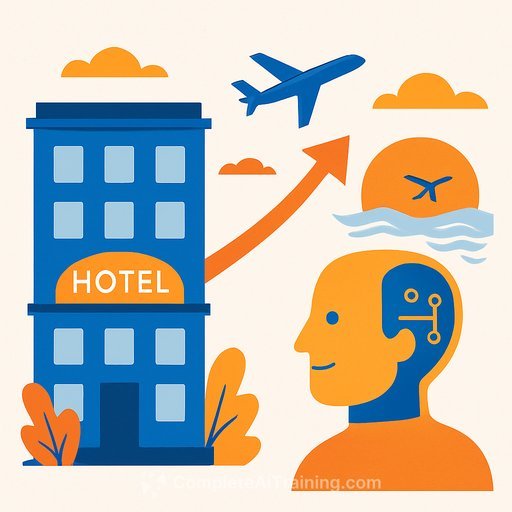The Great Tech Reset: Agentic AI and the Coming Rebalance of Power in Hospitality
The next shift in hotel distribution is here. Agentic AI doesn't just search. It acts, books, and optimizes in real time. That puts your data, your connectivity, and your loyalty engine at the center of revenue strategy.
If your property isn't a clean, direct, and complete source for an AI agent, it will route around you. That means more share to the same middlemen you already pay. The window to reclaim the guest relationship is open-but it won't stay open.
What's Changing
Agentic AI works like a digital concierge with a wallet. It needs one unified feed that exposes every sellable product across rooms, F&B, spa, events, retail, and add-ons. Most hotels don't have this connective layer. Fragmented stacks make your best offers invisible to the new booking flow.
Why Fragmentation Kills AI Performance
The typical stack-PMS, CRS, POS, RMS, spa, events-holds data in silos with different rules. The result is stale rates, mismatched availability, and lost context on the guest. An AI agent can't make strong decisions with gaps like these.
- Inconsistent availability and rate parity across channels
- Ancillaries not packaged with rooms in real time
- Manual exception handling for simple requests
- Long integration queues and brittle, one-off connections
Why Middlemen Keep Winning
OTAs and GDSs aggregate inventory and make it simple to transact at scale. If hotels don't provide a clean, direct alternative, AI agents will default to those networks. Convenience wins the booking.
Open Questions That Hit Your P&L
- When will critical mass of hotels demand unified data layers?
- Will guests trust agents to decide, or still "search and click" by habit?
- Do OTAs morph into agents, or get bypassed when agents go direct to source?
- How do GDSs plug into an agent-first model for B2B travel?
The Vendor Mandate: Build the Unified Data Layer
Agentic AI can't stitch your stack together. Your technology partner must provide the connective tissue: one source of truth, one contract, one set of APIs, and one place to manage products and rules. Hotels shouldn't try to build this in-house.
What "AI-native" looks like: a real-time, bidirectional data stream that exposes every product, constraint, and entitlement. One call should book a corner suite, add late checkout, secure a two-top at 7:30 PM, and schedule a 10 AM spa-confirmed, paid, and synced across all systems.
- Unified product catalog for rooms, rates, packages, F&B, spa, retail, and events
- Live availability, pricing, and restrictions with versioned rules
- Loyalty, identity, and entitlements exposed to the agent at decision time
- Payments, taxes, fees, and cancellation logic standardized
- Event-driven APIs and webhooks for instant updates and confirmations
- Audit logs, rate fences, and offer governance for brand control
Standards help. Explore data models from the OpenTravel Alliance and structured hotel markup from Schema.org to reduce ambiguity.
Build vs. Buy: Selection Criteria
- Can the vendor expose all products through one interface with real-time guarantees?
- Does loyalty, identity, and benefits logic flow into pricing and packaging?
- Is there a clean sandbox, developer docs, and clear SLAs for uptime/latency?
- Are data rights, portability, and event logs clearly documented?
- Can pilots go live in 60-90 days with measurable KPIs?
The Consumer Side: Trust, Delegation, and the Loyalty Trump Card
Guests shift from "search and compare" to "delegate and trust." That trust is earned through relevance and perks. Your lever: loyalty status, benefits, rates, and redemptions exposed directly to the agent.
- Let the agent verify tier, perks, and negotiated rates during the quote
- Package benefits (breakfast, upgrades, late checkout) as rules, not manual notes
- Honor point redemptions and status-based upsells at booking, not arrival
- Publish canonical content and structured data so agents prefer your feed
Expect agents from big tech to broker the guest relationship. Your counter is clarity: reliable data, clear benefits, and a frictionless path to transact.
Playbooks by Segment
Mega Brands: "CRS Is My Fortress"
Modernize the CRS to act as the single interface for agents. Merge loyalty logic with inventory and payments so status impacts packaging and pricing in real time. Dictate participation terms to distribution partners based on your data quality.
- Expose enterprise inventory, benefits, and rates through one contract and API
- Guarantee low-latency quotes and confirmations across brands and regions
- Centralize offer governance to prevent channel conflict
Mid-Sized & Small Brands: The Strategic Partner Play
You don't need 20 integrations. You need one strong platform. Consolidate data into a modern CRS with payments, loyalty, and ancillaries built in.
- Choose a vendor that ships a full product catalog and live pricing out of the box
- Stand up 1-2 pilot properties and prove uplift in direct agent bookings
- Roll out brand-wide once attach rates and NRevPAR improve
Independents: The Direct Connectivity Mandate
Win on uniqueness and clarity. A "master hotel code" or equivalent consolidates PMS, rates, F&B, and experiences so agents can sell everything you offer.
- Pick one platform to run booking, payments, ancillaries, and content
- Publish rich attributes: views, bedding, breakfast details, proximity to trails, etc.
- Automate instant confirmations for rooms, tables, and spa in one flow
90-Day Action Plan
- Audit stack: list systems, data owners, APIs, and latency bottlenecks
- Map products: rooms, add-ons, F&B, spa, events, retail; define rules and constraints
- Select partner: run RFP with the checklist above and a pilot commitment
- Pilot 1-2 properties: expose full catalog; test loyalty-aware quotes
- Instrument: measure conversion, attach rate, latency, error rate, and NRevPAR
- Enable content: structured descriptions, images, attributes, and rate fences
- Train teams: revenue, sales, and ops on packaging and exception handling
KPIs That Matter
- Mix shift: OTA share down; direct agent share up
- NRevPAR: revenue net of acquisition cost
- Attach rate: ancillaries per booking and revenue per stay
- Quote-to-book time and confirmation latency
- Error rate on availability, pricing, and payment
Risks and How to Reduce Them
- Vendor lock-in: require data export, event logs, and 90-day portability clauses
- Privacy/compliance: enforce least-privilege access and clear retention rules
- Channel conflict: codify rate/benefit parity and blackout logic
- Operational strain: phase rollout, start with high-margin use cases
- Resilience: keep a failover path to existing channels during transition
What Success Looks Like
Your property is a preferred data source for agents. Guests book stays, tables, and spa in one action. Loyalty benefits apply at quote time. OTA commissions drop. NRevPAR and guest satisfaction rise because the full experience is packaged, priced, and confirmed instantly.
Next Steps
- Shortlist vendors that can deliver a unified catalog and loyalty-aware pricing
- Launch a pilot and tie compensation to direct agent share and NRevPAR
- Upskill your team on AI-first distribution and data quality practices
If you need structured learning for your team, explore practical AI programs for hospitality roles: AI courses by job and AI Automation Certification.
The Final Word
Distribution won't flip overnight, but the balance is shifting. When a guest asks their agent to book, you're either visible and bookable-or you're not. Choose to be the source.
Your membership also unlocks:






